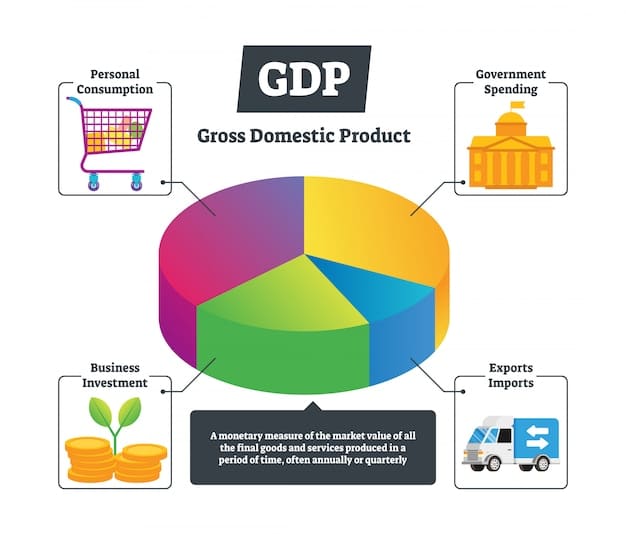Pell Grants Increase: Decoding the 8% Budget Boost in 2025

The potential 8% increase in Pell Grants within the new federal education budget for 2025 represents a significant opportunity for students to afford higher education, potentially reducing financial barriers and expanding access to college.
Is the promise of an 8% increase in Pell Grants in the new federal education budget for 2025 just talk, or a real game-changer for students? Let’s break down what this potential boost could mean for you and the future of higher education.
Understanding Pell Grants and Their Importance
Pell Grants, a cornerstone of federal student aid, play a critical role in making higher education accessible to millions of Americans. These grants, unlike loans, do not need to be repaid, making them a vital resource for students with financial needs. Understanding the significance of Pell Grants requires a closer look at their history, eligibility criteria, and impact on college affordability.
The History of Pell Grants
Established in 1972, Pell Grants were created to provide need-based financial aid to undergraduate students. Over the decades, they have evolved to address increasing college costs and the growing need for a skilled workforce. Originally known as Basic Educational Opportunity Grants (BEOG), they were renamed in honor of Senator Claiborne Pell in 1980, recognizing his dedication to education.
Eligibility and Application Process
To be eligible for a Pell Grant, students must demonstrate financial need, be enrolled in an eligible degree or certificate program, and meet certain citizenship requirements. The application process begins with the Free Application for Federal Student Aid (FAFSA), which assesses a student’s financial situation and determines their Expected Family Contribution (EFC). The EFC is then used to calculate the student’s Pell Grant eligibility.
- FAFSA Completion: Complete the FAFSA form online, providing accurate financial information.
- Demonstrate Need: Show a significant financial need based on your EFC.
- Enrollment: Be enrolled in an eligible degree or certificate program at a participating institution.
- Citizenship: Meet U.S. citizenship or eligible non-citizen requirements.
The maximum Pell Grant amount changes annually, often reflecting adjustments to the federal budget and the cost of living. These adjustments are crucial to ensuring that the grants keep pace with rising tuition costs. The grants are typically disbursed directly to the educational institution, which then applies the funds to the student’s tuition, fees, and other educational expenses.
Understanding Pell Grants is essential for students and families navigating the complex landscape of college financing. These grants provide a crucial foundation for accessing higher education and achieving academic and career goals.
Examining the Proposed 8% Increase
The proposed 8% increase in Pell Grants within the new federal education budget has garnered attention and sparked debate among students, educators, and policymakers. To fully understand the implications, it’s essential to analyze the potential benefits and drawbacks of this increase.
Potential Benefits for Students
An 8% increase in Pell Grants could provide significant financial relief to students. This boost could help cover a larger portion of tuition costs, reduce the need for student loans, and make higher education more accessible to low-income students.
Impact on College Affordability
With college tuition rates continuing to rise, an increase in Pell Grants could help mitigate the financial burden on students. By providing more grant aid, students may be able to afford to attend higher-priced institutions or pursue longer educational programs without accumulating excessive debt. This can lead to improved educational outcomes and increased economic mobility.

- Reduced Loan Burden: Lower reliance on student loans, leading to less debt after graduation.
- Increased Access: More students, particularly those from low-income backgrounds, can afford college.
- Improved Completion Rates: Financial stability can lead to better academic performance and higher graduation rates.
However, it’s important to consider the potential drawbacks. An 8% increase may not be sufficient to fully address the rising costs of tuition at many institutions. Additionally, the increased funding may not reach all eligible students if the application process remains complex or if there are administrative delays. Balancing the benefits and drawbacks is crucial for assessing the true impact of the proposed increase.
The proposed 8% increase in Pell Grants has the potential to significantly improve college affordability and access. By carefully evaluating its benefits and drawbacks, policymakers can ensure that it effectively supports students in achieving their educational goals.
The Federal Education Budget and its Priorities
The federal education budget reflects the government’s priorities and commitment to supporting education at all levels. Understanding the budget’s key components and how funds are allocated provides valuable insight into the future of education in the United States. The federal education budget is a complex document that outlines funding for various educational programs, including Pell Grants, student loans, and K-12 initiatives.
Key Components of the Budget
The federal education budget is typically divided into several key areas, including elementary and secondary education, higher education, and vocational training. Each area receives a specific allocation of funds based on the government’s priorities and the perceived needs of the education system.
How Funds Are Allocated
Funds are allocated through a combination of formulas and competitive grants. Formula grants are distributed to states and institutions based on factors such as student enrollment and poverty rates. Competitive grants, on the other hand, are awarded to applicants who demonstrate the most innovative and effective approaches to addressing educational challenges.
- Formula Grants: Distributed based on predetermined criteria, such as student population and socioeconomic indicators.
- Competitive Grants: Awarded to projects and programs that demonstrate innovative approaches and potential for success.
- Discretionary Spending: Allocations determined annually by Congress, allowing for flexibility in addressing emerging needs.

The budget also includes funding for research and development, which supports efforts to improve teaching methods, develop new educational technologies, and address equity gaps. Additionally, the federal education budget often includes provisions for addressing specific challenges, such as teacher shortages, school infrastructure needs, and the rising cost of college.
The federal education budget serves as a roadmap for supporting education in the United States. By understanding its key components and priorities, stakeholders can advocate for policies and funding levels that promote equitable access to high-quality education for all students.
Analyzing Historical Trends in Pell Grant Funding
Examining historical trends in Pell Grant funding provides valuable context for understanding the proposed 8% increase. By analyzing past funding levels, adjustments, and their impact on student access, we can better assess the potential implications of this proposed change. Tracking historical trends in Pell Grant funding involves looking at several key factors, including the total amount allocated to the program each year, the maximum Pell Grant award, and the number of students receiving grants.
Past Funding Levels and Adjustments
Over the years, Pell Grant funding has fluctuated based on economic conditions, political priorities, and the changing needs of students. During periods of economic growth, funding may increase to support expanded access to higher education. Conversely, during economic downturns, funding may be reduced or frozen as policymakers grapple with budget constraints.
Impact on Student Access and Affordability
Historical data shows a direct correlation between Pell Grant funding levels and student access. When funding increases, more low-income students are able to afford college, leading to higher enrollment rates and improved educational outcomes. Conversely, when funding decreases, student access is often restricted, contributing to widening equity gaps.
Furthermore, historical trends reveal the impact of Pell Grants on college affordability. As tuition rates have risen, the purchasing power of Pell Grants has declined, making it more difficult for students to cover the full cost of attendance. Adjustments to the maximum Pell Grant award have often lagged behind tuition increases, resulting in a growing gap between financial aid and the actual cost of college.
- Enrollment Rates: Analyzing how Pell Grant funding impacts enrollment rates among low-income students.
- Graduation Rates: Assessing the correlation between Pell Grant funding and graduation rates.
- Debt Burden: Examining how Pell Grant funding affects the amount of student loan debt accumulated by graduates.
By analyzing historical trends in Pell Grant funding, we can gain a deeper understanding of the program’s effectiveness and identify areas for improvement. This evidence-based approach can inform policy decisions and ensure that Pell Grants continue to play a vital role in promoting college access and affordability.
Understanding past trends in Pell Grant funding is crucial for evaluating the potential impact of the newly proposed increase and ensuring that it effectively addresses the ongoing challenges of college affordability and access.
Alternative Perspectives on Education Funding
While Pell Grants are a critical component of federal financial aid, it’s important to consider alternative perspectives on education funding. Exploring different approaches and innovative strategies can help create a more comprehensive and equitable system for supporting students. Alternative perspectives on education funding encompass a wide range of ideas, including tuition-free college, income-based repayment plans, and targeted scholarships.
Tuition-Free College Proposals
Many advocates argue that tuition-free college is the most effective way to promote college access and affordability. Under this model, states or the federal government cover the cost of tuition at public colleges and universities, eliminating the financial barrier for students.
Income-Based Repayment Plans
Income-based repayment (IBR) plans are designed to make student loan repayment more manageable by tying monthly payments to a borrower’s income and family size. These plans can provide significant relief to graduates who are struggling to repay their loans, reducing the risk of default and improving financial stability.
Another alternative is targeted scholarships, which provide financial aid to students based on specific criteria, such as academic achievement, field of study, or demographic background. These scholarships can help incentivize students to pursue high-demand fields, promote diversity in higher education, and reward academic excellence.
- Increased Philanthropy: Encouraging private donors and foundations to invest in education through scholarships and grants.
- Employer Partnerships: Developing partnerships between colleges and employers to provide tuition assistance and job training.
- Innovative Financing: Exploring alternative financing models, such as social impact bonds, to support education initiatives.
By considering alternative perspectives on education funding, policymakers can create a more holistic and effective system for supporting students. This approach can help address the complex challenges of college affordability, promote equitable access to education, and prepare students for success in the 21st-century workforce.
Exploring alternative perspectives is crucial for developing a comprehensive approach to education funding that can best support students from all backgrounds.
Challenges and Opportunities Ahead
Looking ahead, the landscape of higher education presents both challenges and opportunities. Addressing these challenges and capitalizing on the opportunities will be essential for ensuring that all students have access to a high-quality education. One of the biggest challenges facing higher education is the rising cost of tuition. As tuition rates continue to climb, many students are finding it increasingly difficult to afford college, leading to higher levels of student debt and reduced access for low-income students.
Addressing the Rising Cost of Tuition
To address this challenge, policymakers and institutions must work together to control tuition costs and find innovative ways to make college more affordable. This could include increasing state and federal funding for higher education, implementing tuition freezes, and developing cost-saving measures within institutions.
Expanding Access for Underserved Students
Another significant challenge is the persistent equity gaps in higher education. Students from low-income backgrounds, minority groups, and rural areas often face barriers to college access and success. To address these gaps, institutions must implement targeted outreach programs, provide additional financial aid, and create supportive learning environments.
Despite these challenges, there are also many opportunities to improve higher education. Technology can play a key role in enhancing teaching methods, expanding access to online learning, and developing personalized learning experiences. Additionally, there is growing recognition of the importance of career-focused education, which prepares students for high-demand jobs and contributes to economic growth.
- Leveraging Technology: Utilizing technology to enhance teaching, expand access, and personalize learning.
- Promoting Career-Focused Education: Developing programs that prepare students for high-demand jobs.
- Strengthening Partnerships: Building partnerships between colleges, employers, and community organizations to support student success.
By addressing the challenges and seizing the opportunities ahead, we can create a stronger, more equitable, and more effective higher education system. This will require collaboration, innovation, and a commitment to ensuring that all students have the chance to reach their full potential.
The path ahead requires a proactive approach to addressing challenges and leveraging opportunities to ensure a brighter future for higher education.
| Key Point | Brief Description |
|---|---|
| 💰 Pell Grants | Federal aid for low-income students; grants don’t need to be repaid. |
| 📈 Proposed Increase | New budget suggests an 8% increase in Pell Grant funding for 2025. |
| 🎓 Impact | Aims to boost college affordability and access for students in need. |
| ⚖️ Considerations | Must address rising tuition and ensure aid reaches eligible students. |
FAQ
▼
Pell Grants are federal financial aid offered to undergraduate students with exceptional financial need. These grants do not need to be repaid, making them crucial for low-income students pursuing higher education.
▼
The FAFSA (Free Application for Federal Student Aid) assesses a student’s financial situation and calculates their Expected Family Contribution (EFC). This EFC helps determine the student’s eligibility for a Pell Grant and other federal aid.
▼
The 8% increase is a proposal within the new federal education budget. Its confirmation depends on congressional approval and the final budget allocation for Pell Grants in 2025.
▼
Increasing Pell Grants can significantly improve college affordability and reduce the need for students to take out loans. This expansion of financial aid could lead to higher enrollment and graduation rates.
▼
Alternatives include tuition-free college proposals, income-based repayment plans for student loans, and targeted scholarships designed to support students based on specific criteria or academic pursuits.
Conclusion
In conclusion, the potential 8% increase in Pell Grants is a promising step toward making higher education more accessible and affordable. While challenges remain, such as rising tuition costs and equity gaps, this proposed increase could provide much-needed financial relief to students. It will be essential to continue exploring innovative strategies and funding models to ensure all students have the opportunity to pursue their educational goals.





